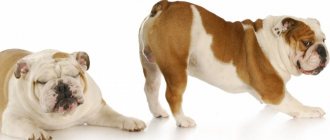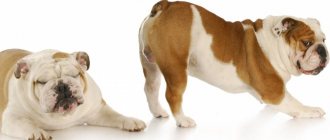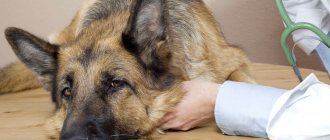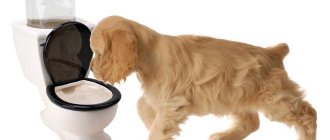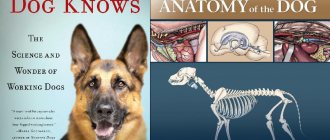The pug is the same dog whose expressive face immediately shows whether she is happy or sad, feels good or something is bothering her. It is not difficult to understand that something is hurting your pet; it is difficult to identify the cause of the illness. That is why the owner of a pug needs to have at least a minimal understanding of his pet’s diseases and their symptoms in order to be able to provide help to his four-legged friend if necessary.
How to understand that you are sick?
If your pug isn't feeling well, it will affect his behavior.
The dog will sleep more than usual, become lethargic and sad, or may begin to show previously uncharacteristic aggression and anger.
You need to pay attention to any slightest changes in the behavior and character of the pug. In addition, you should pay attention to discharge from the nose and eyes, as well as your pet’s feces.
If the animal starts vomiting and the temperature rises, you should not hesitate and should contact a veterinarian as soon as possible; the same should be done if the dog is scratching its eyes. All of these are warning signs indicating the presence of serious health problems.
Character
Pugs are an incredible combination of kindness and charm, playful nature and intelligence. Yes, at times they can show rare stubbornness, but in general they have a balanced character, with a sense of self-esteem.
The little pug sincerely becomes attached to his owner and even gets jealous if he shows favor to other people. Representatives of this breed easily get along with all family members, patiently endure children's pranks and are lenient towards other pets.
Pugs are unusually good-natured, trusting and inquisitive, and these qualities can play a cruel joke on them. Seeing a friend in every person, a good dog can easily follow a stranger. That is why, in order to avoid theft of your pet, you need to carefully monitor it during a walk.
Despite their modest size, pugs can perform security functions and show courage, which is not required of them. These kids love to keep everything under control and clearly react to the slightest suspicious rustle in the house.
Many people think that pugs are a very lazy breed. Of course, they are not at all averse to lying down imposingly next to their owner on a soft sofa, but with the same pleasure they will go for a walk with him to play and run.
Predisposition
Anyone who has decided to get a pug needs to know that, in addition to other diseases, there are diseases that are characteristic of this particular breed of dog. Among such ailments, veterinarians note:
- Aseptic necrosis of the femoral head.
- Juvenile demodicosis.
With the first disease, there is a disturbance in the blood flow of the femoral head, resulting in disturbances in the functionality and mobility of the joint. The result of this process is the pet's lameness, and if the disease is not treated, it not only gets worse, but the muscles of the entire paw can atrophy. It is quite understandable that in this case the pug becomes lethargic, does not feel the desire to walk and walk, lies down a lot, which negatively affects the general condition of the body.
The life expectancy of a pet with aseptic necrosis of the femoral head is reduced to 7 years, and if treatment is not started in time, it can become disabled at 4 years.
The only way to treat this disease is surgery, after which the pug will again become cheerful and cheerful.
Juvenile demodicosis also affects a pug's lifespan and can ruin its appearance.
The disease is caused by the demodex skin mite, which settles and multiplies in the hair follicles and sebaceous glands of animal skin.
The result of demodicosis is thinning, and in some places, completely falling out hair.
The dog is constantly itching and the resulting wounds get infected, causing inflammation and the appearance of small abscesses and crusts.
If you do not start fighting the parasite in a timely manner, its larvae can enter the dog’s bloodstream, affecting the tissues of various organs and lymph glands. The animal becomes very thin and weak, and over time, exhaustion and general sepsis develop. Without treatment, the dog may die.
Unlike ordinary allergies, juvenile demodicosis is characterized by the presence of red pimples with a dark dot in the center on the animal's abdomen or genitals.
The pug also has a tendency to obesity and excess weight, for which the owners are most often to blame. It is necessary to exclude fatty meats, baked goods, various sweets and other foods that increase weight from the dog’s diet. The pug's diet must be correct and balanced, and physical activity must be regular.
Prevention, healthy lifestyle
The most important thing you should not forget is that timely vaccinations are the key to the health of any dog, including a pug.
Since pug dogs have very poor health, they require special care . To avoid skin problems, dogs should be washed once every two weeks, and the numerous folds of the skin should be thoroughly wiped. After water procedures, the dog must be thoroughly dried. This care is due to the fact that after a walk, dirt and moisture can accumulate in the folds, which in turn causes the accumulation of bacteria and inflammation of the skin.
In order to protect pugs from such dangers as allergies, you need to know which products are the most dangerous in this regard. The main foods that can cause an allergic reaction include: chicken, eggs, some types of fish, dairy products and sausage in any form. Dog owners, often wanting to please their pet with a treat, themselves provoke various diseases.
Important! Pugs should absolutely not be given sweets, smoked and salty food, as well as any food from the table. Cheap economy-class food is also contraindicated for these dogs. Also, you should not skimp on pug care products; low-quality shampoos and care products can cause such a serious skin disease as dermatitis.
Pugs are very active dogs, but it is strictly not recommended to overexert them physically, especially in the summer, as they have a very weak heart. These dogs do not tolerate extreme heat and stuffiness indoors. For walks in the cold season, you need to buy warm overalls for your pug; these dogs do not tolerate frost well. After severe hypothermia, your pet may develop pneumonia or bronchitis, and if a complication occurs, it can end very sadly.
Another very dangerous disease for which only the owner himself is to blame is obesity . It is not hereditary and is not caused by the pug's weak immune system. In turn, obesity can cause diseases of the heart and internal organs. In order to avoid problems with excess weight, you must carefully maintain a balance of good nutrition and physical activity.
Return to content
Eyes
The large and expressive eyes of pugs are the calling card of the breed and one of the main problems of the owners.
Cataracts and conjunctivitis
One of the pug's problems is cataracts, which is inflammation and clouding of the eyeball.
You can notice signs of the disease not only by examining the eyes, but also by the behavior of the pet, which, due to deteriorating vision, may begin to bump into objects.
If left untreated, cataracts can cause your dog to become blind . Treatment is carried out surgically. In case of inflammation of not only the eyes, but also the area around them, we can talk about conjunctivitis. This disease is dangerous because, due to infection, it can cause more dangerous inflammation.
In this case, you need to forget about walking for a while. You need to treat your pug's eyes with a cotton swab dipped in chamomile infusion and contact a veterinarian, who will prescribe special drops.
Eyeball prolapse
It happens that pug owners have to deal with such a problem as the dog’s eyeball falling out of the orbit.
This problem may occur due to a blow or insect bite. It is perhaps the most common ailment for pugs.
This is definitely an unpleasant and even terrifying sight. However, you must not lose your composure and take active actions - this can only harm the dog. You need to take a piece of clean, damp cloth, apply it to your pet's eye and immediately take your pug to a veterinarian, who will help restore the eye.
If for some reason it is not possible to go to a veterinary clinic, you need to act independently. It is necessary to wash and, preferably, disinfect your hands, take a bandage and press your hands on the eyeball. Then close the pug’s eyelid and apply a sterile bandage for several hours.
If nothing is done, the dog could face surgery and loss of the eye.
Cornea problems
Another common pug eye disease is keratitis , an inflammation of the cornea of the eye. Main symptoms of keratitis:
- Redness of the eye.
- Sores.
- Cloudiness in the eye.
The disease is the result of exposure to external factors or allergies. Such a phenomenon as pigmentary keratitis is characterized by the proliferation of eye pigment. The disease is treated with local medications or surgery.
Genetic pathologies of the legs
Perthes disease is associated with poor blood supply to the femoral head. The disease usually begins in puppyhood. At the initial stage it is quite difficult to determine. The dog begins to limp and stops leading an active lifestyle.
Due to poor muscle function, the leg begins to dry out and the pet refuses to walk at all, as this causes severe pain. Typically, pugs with this diagnosis live no more than seven years.
Treatment: it is possible to correct the situation only by surgery. The surgeon makes the final diagnosis based on an x-ray. After the operation, the dog quickly gets back on its feet, lameness disappears and it begins to live a normal life.
Skin diseases
The most common skin disease of pugs is juvenile demodicosis.
However, allergic reactions accompanied by itching are no less common.
Because of this, the dog scratches the problem area, sometimes to the point of meat. In order not to mistake allergy symptoms for bites of fleas or other parasites, it is necessary to examine the genitals and abdomen of the pet.
If there are no characteristic red pimples with a red dot in the center, it is an allergy. Atopic dermatitis, which appears as itchy, inflamed areas on the face, armpits, between the toes and around the anus, is caused by food allergens, pollen, house dust and others. The disease is treated by subcutaneous injection of the allergen in gradually increasing concentrations.
All procedures must be carried out only in a veterinary clinic!
Breed standard
Pugs are compact, proportionally built dogs with well-developed muscles. A characteristic feature is the wrinkles on the muzzle, which form a beautiful symmetrical pattern. At the same time, the folds of the skin do not sag, like in bulldogs.
Males weigh 4-8 kilograms, height at the withers is no more than 32 centimeters. Bitches weigh up to 5 kg, height – 28-30 cm.
External characteristics:
- The head is medium size. The muzzle is flattened, with few folds.
- The eyes are large, round, widely spaced, convex, located in line with the nose (necessarily black).
- The nostrils are large and well open.
- The jaw is strong, the bite is a light bite.
- The ears are small, thin, and high set. There are two types of ears: “roses” and “buttons”. The second type is preferable.
- The body is short, stocky, dense.
- The neck is thick, square, with a slight bend. Visually resembles a comb. The scruff is well developed.
- The chest is wide, the ribs have a pronounced curve.
- The tail is high, curled tightly under the hip. A double curl is desirable.
- Limbs are short, strong, straight.
Pugs' fur is short, thick, and pleasant to the touch. As for colors, the most common are apricot and gray-silver. If the color is light, a black mask on the face and ears is required. There may be a dark “strap” on the ridge from the back of the head to the tail.
Ears
Ear diseases are not uncommon for pugs. The most common among them is otitis , the symptoms of which are:
- The dog's desire to scratch its ears.
- Discharge of foul-smelling mucus from the ears.
- Temperature increase.
- Swelling and redness of the ears.
- Lethargy and drowsiness of the pet.
To prevent disease, you need to clean your pug's ears regularly. If the dog's ears are hot and inflamed, ulcers and crusts appear on them, the pet shakes its head. When you squeeze your ear, you may hear a squelching sound, most likely caused by microscopic ear mites.
Only a veterinarian can make a diagnosis. Under no circumstances should you treat an animal yourself. Anti-mite medications can cause side effects.
In addition, an insect can get into your pug's ear. You can try to remove it yourself by laying the dog on its side and dripping vegetable oil into the ear. If the insect surfaces, you can remove it; if not, you should consult a doctor so as not to worsen the situation.
Ears leaking
In addition to diseases of the eyes, skin and legs, pugs have a number of other problems.
Otitis
Ear inflammation is associated with narrow ear canals in pugs. Symptoms by which you can identify the disease yourself from the first days:
- the dog constantly scratches its ears;
- mucus is released from the auricle and an unpleasant, pungent odor is felt;
- the dog becomes inactive and sleeps constantly;
- the temperature is slightly elevated;
- the ears have slight swelling and redness.
Treatment: ear hygiene and Otipax drops. They relieve inflammation and pain in the ears.
Gastrointestinal tract
In addition to other diseases, pugs are characterized by diseases of the gastrointestinal tract. The most common of which are gastritis and colitis.
Gastritis is inflammation of the gastric mucosa. The main signs of the acute form of this disease are vomiting, refusal to eat, lethargy, coated tongue, elevated body temperature, abdominal pain, in which the pug hunches over, and the animal is in pain during palpation of the stomach.
It is necessary to begin treatment with a starvation diet. To drink, you should give your pug warm tea and place a hot heating pad on his stomach.
If you do not follow a diet, acute gastritis will develop into chronic.
This disease is less noticeable, since vomiting occurs infrequently, and appetite is not always absent. Vomiting in chronic gastritis consists of undigested food and clear mucus.
Colitis is inflammation of the intestinal mucosa . The disease is a complication after another illness, most often plague, or occurs as a result of improper feeding. For example, if the dog ate low-quality oil or fatty meat.
Colitis can also be caused by eating boiled meat and boiled bones, leftovers from people's dinners, too cold or very hot food, and water from dirty puddles. In addition, the presence of worms or poisoning can provoke the disease.
Signs of the disease are diarrhea mixed with mucus and blood, and a bad odor from the mouth.
Symptoms of acute colitis are pain, lack of appetite, thirst.
If a pug eats incorrectly for a long time, the acute form of colitis becomes chronic.
The pet loses weight, hunches over, its fur becomes dull, and interest in the world and cheerfulness disappear.
With colitis, diet is very important; you should not overload the intestines. It is necessary to exclude fats, sugar, bones, vegetables, and grain products from the diet.
Also, diarrhea in a pug can occur due to poisoning, harmful or unusual food, infection, nervous excitement or hypothermia. Constipation can be caused by an unhealthy diet, lack of water, or a sedentary lifestyle.
In order to bring your pet back to normal, it is necessary to limit its food intake. Replace the pug's usual food with oatmeal porridge cooked in water.
Typical Pug Diseases
If the dog for some reason began to limp, although there were no injuries, aseptic necrosis of the femoral head is possible, i.e., poor circulation of the femurs. Often the disease affects both hind legs. The pug becomes inactive, reacts painfully to touching its paw, and it begins to fail. Later, the necrotic process affects the entire limb: the muscles on the affected paws dry out.
Treatment is only possible with surgery, but mobility returns soon after surgery. Pugs are genetically predisposed to such limb problems. You should act quickly before your paws give out. A problem in small dogs is necrotizing meningoencephalitis: inflammation of the central nervous system. Manifested by convulsions, involuntary movements of the pupils, paralysis. Aggressive immunosuppressive treatment is required.
A deadly disease is pug encephalitis. The animal experiences seizures similar to epilepsy, its legs give way, its head twitches, tremors and convulsions occur. Encephalitis can develop due to a tick bite, but often the cause cannot be found.
It is believed that this disease may also be hereditary. In middle-aged and elderly bitches, the uterus may become inflamed. This provokes frequent urination, severe thirst, and lethargy. Purulent discharge from the loop is possible. Urgent treatment is necessary, sometimes it is necessary to resort to removal of the uterus and ovaries.
Pugs often grunt and cough: the reason is the so-called. brachycephalic syndrome in pugs, caused by a long palate with a short muzzle. In this case, the dog may have difficulty breathing, grunting, due to heat and fatigue (pugs often begin to choke at the end of a long walk), as well as illness (runny nose, etc.). A pug often grunts when it feels happy or stressed. The tendency to this problem is also hereditary: if the parents often suffocated, the puppies will also be prone to this.
If a dog coughs as if he is choking, this is a “reverse sneeze” - the dog is trying to clear his airways. This cough can be similar to gagging, and sometimes actually turns into vomiting. Periodically, this cough occurs in many dogs with a short muzzle and goes away on its own, but if the attacks become more frequent, consultation with a specialist is necessary. The dog could either simply catch a cold or become seriously ill, including heart problems. It is also worth checking whether a choking dog has foreign objects in the nasopharynx.
Similar article: History of the appearance and characteristics of the mini-pug breed
If a pug snores, it may be a genetic trait (about 20% of pugs snore, another manifestation of brachycephalic syndrome). But if this has not happened before, the cause of snoring may be an allergic runny nose, a cold, excess weight, sleep apnea, when the dog suffocates for a moment, etc. If your pug snores with frequent choking or coughing, you should consult a veterinarian. which will tell you whether it is necessary to eliminate the allergic factor, treat a runny nose or undergo surgery.
A cough and runny nose themselves can either mean that the dog has a slight cold or be symptoms of an infection. For example, “kennel cough” occurs after contact with other dogs: exhibitions, training on the site, etc. A runny nose and sneezing, which causes snot, can occur due to allergies. One of the common causes is also rhinitis - in this case, a runny nose, if you do not take active treatment, sometimes lasts for years. In all these cases, it is necessary to contact a veterinarian.
Urolithiasis
A common occurrence for pugs is urolithiasis, the symptoms of which are:
- Frequent urination.
- The color of the urine becomes cloudy, and sometimes pus can be found in it.
- A dog may urinate at home.
- The pet becomes lethargic and apathetic and refuses to eat.
- The pug licks his genitals more often than usual.
First of all, the veterinarian will prescribe diuretics to get rid of stagnant urine. Further treatment directly depends on the specific case and the size of the stones. Sometimes it happens that the only treatment option is surgery.
Are you susceptible to illness?
Pugs are a rather sick breed of dog; the diseases of these animals are very diverse.
IMPORTANT!
The most common disease is allergies, which can have different origins.
Also among the diseases quite common are obesity , breathing problems and eye disease, and colds .
Pathologies of the motor system, sores on the head and gastrointestinal disorders are also characteristic of the pug breed.
Internal parasites
The most common types of internal parasites include helminths of the roundworm class and the tapeworm class, colloquially called roundworms and tapeworms, respectively. Helminth infections are diseases caused by parasites that lead to disorders of the gastrointestinal tract, as well as increased susceptibility to various diseases. Symptoms of parasite infection: diarrhea followed by constipation, vomiting, colic, decreased or increased appetite. The coat is brittle, thin, tousled. In addition, general intoxication of the dog’s body is possible. Worms are especially dangerous in puppies, as they can be fatal. Therefore, it is necessary to carry out deworming quarterly. Deworming is carried out in 2 stages: initial intake and repeat after 10 days.
Vaccinations by age (table)
| Puppy age | Vaccine |
| 8 weeks | From 5 infections:
|
| 12 weeks | From 7 infections:
|
| Every 4 months | Antihelminthic prophylaxis using drugs:
|
| 1 year | From 7 infections:
Repeat annually throughout your life. |
Symptoms of illness
Signs of poor health in pugs depend entirely on the disease. The main symptoms that your pet is sick are: diarrhea, vomiting, itching, redness and inflammation of the eyes and ears.
Correct and timely diagnosis is the key to quick and successful treatment of your pet..
If there are signs of poisoning, then the animal's droppings are taken for analysis.
You can diagnose any skin diseases by scraping the epithelium on the affected area of your pet's skin.
In case of injuries, as well as in cases where the animal’s paws fail, it is recommended to take an x-ray.
Parvovirus enteritis
Parvovirus enteritis is a highly contagious viral disease characterized by inflammation and necrosis of the intestinal mucosa. In young dogs, especially puppies, enteritis is accompanied by myocarditis (damage to the heart muscle).
Dogs of all ages are susceptible, especially dogs 2 months to a year old.
The first symptoms of the disease are lethargy, refusal to feed, the puppy tries to lie on its stomach on a cold surface, vomiting with foam, and diarrhea with a very specific smell. At first, vomiting and diarrhea are sporadic, then indomitable. During this stage, dehydration progresses, which can cause shock and death. The course of the disease sometimes develops so rapidly that the loss of every hour can cost the animal its life.
With careful attention to your pet, the onset of the disease can be recognized in the first hours. Whether your baby will survive depends on competent and decisive actions in the first hours of illness. A home veterinary kit contains all the medications needed to provide emergency care.
- water is replaced with rehydron solution (helps against dehydration) 1 teaspoon every half hour;
- fosprenil (antiviral drug) - days 1, 2, 3, 4 times one dose intramuscularly, then according to the scheme;
- Gala-Vet 0.04 ml or 1 ml Vitacan subcutaneously 3-4 times every 12-24 hours;
- sulfocamphocaine - 0.3 ml subcutaneously 2 times a day;
- Raglan or Cerucal (antiemetic) 0.5 ml 2 times a day;
- gamavit or aminovit - 0.5 ml subcutaneously 2-3 times a day;
- it is very desirable to take chloramphenicol succinate for injection (a powerful antibiotic) - 25 mg per 1 kg of weight 2 times a day with an interval of 12 hours. If there is no chloramphenicol, then gentamicin 0.3-0.5 ml, depending on the age of the dog, 2 times a day intramuscularly.
Do not give pills, they will only cause vomiting and make the situation much worse.
Without wasting time, call the doctor and do not stop treatment until he arrives. It should be remembered that after treatment the dog needs a diet.
Encephalitis
Encephalitis is a neurological disease, inflammation of the brain caused by pathogens. The charming pug suffers from this disease quite often. It can cause convulsions, poor coordination of the animal’s movements, and provoke aggression or lethargy unusual for the breed.
Pug encephalitis usually appears in adulthood. There is no information about the cause of the disease and, to the deepest regret of the owners, this is a disease that cannot be cured by any means. The most you can do to help your pet is to give him corticosteroids (anti-inflammatory hormones) to reduce the tumor.
Infectious hepatitis
Young dogs, under the age of one year, as well as weakened and worm-ridden animals are most susceptible to infection with viral hepatitis. The disease begins with gradually increasing lethargy, the dog becomes inactive, refuses food, lies down more, has difficulty standing, and has an unsteady gait. Next, characteristic signs of hepatitis appear: vomiting mixed with bile, unilateral or bilateral keratitis (whitish clouding of the cornea) and tonsillitis. Urine becomes dark brown. The disease occurs in hyperacute, acute, subacute and chronic forms.
The hyperacute and acute forms most often affect puppies and young dogs, while the subacute and chronic forms affect older dogs. In the hyperacute form, sudden death of puppies for no apparent reason is observed. Puppies 2-6 months old are susceptible to the acute form. The duration of the disease is 3-7 days. During the entire time, the temperature remains at 40-41 degrees, there is no appetite, thirst, and frequent vomiting. Diarrhea appears the next day or every other day with pieces of undigested food. The death rate of puppies reaches 70%.
Animals that have recovered from the disease develop long-term immunity. At the first signs, you should immediately consult a doctor.
Before the doctor arrives, the following measures should be taken:
- peace and warmth;
- do not force feed;
- drink plenty of fluids (not with water), but with rehydron solution;
- immunofan, ribotan, vitacan - apply any immunomodulator 3-4 times with an interval of 12-24 hours subcutaneously;
- gamavit or aminovit - 0.5 ml subcutaneously 2-3 times a day;
- fosprenil - the first day 4 times 1 dose, then according to the scheme;
- furazolidone ½ tablet 2 times a day;
- Raglan or Cerucal (antiemetic) 0.5 ml 2 times a day;
- sulfocamphocaine - 0.3 ml subcutaneously 2 times a day.
Further treatment should be agreed with your doctor.
